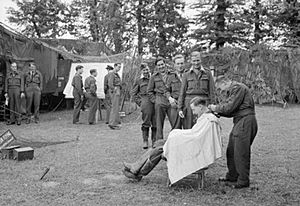No. 65 Squadron RAF facts for kids
Quick facts for kids No. 65 (East India) Squadron RAF |
|
|---|---|
| Active | 1 August 1916 (RFC) to 1919 1934–1961 1964–1970 1970–1974 1986–1992 |
| Country | |
| Branch | |
| Motto(s) | Latin: Vi et armis "By force and arms" |
| Battle honours | Western Front, 1917-1918*: Cambrai, 1918*: Somme, 1918*: France & Low Countries*: Dunkirk: Battle of Britain, 1940*: Home Defence, 1940-42: Fortress Europe, 1941-1944*: Channel & North Sea, 1942-1945*: Dieppe: Normandy, 1944: Arnhem: France & Germany, 1944-1945*: Baltic 1945: Honours marked with an asterisk are those emblazoned on the Squadron Standard |
| Insignia | |
| Squadron Badge heraldry | In front of fifteen swords in pile, the hilts in base, a lion passant. The number of swords refers to a memorable combat in which fifteen enemy aircraft were destroyed. |
| Post 1950 Squadron Roundel |  |
No. 65 Squadron was a famous flying unit of the Royal Air Force (RAF). It was known for its brave pilots and powerful aircraft. The squadron served in many important conflicts. These included both the First World War and the Second World War. Over the years, it flew many different types of planes. These ranged from early biplanes to fast jet fighters.
First World War Service
The squadron first started on August 1, 1916. It was part of the Royal Flying Corps. This was the UK's air force before the RAF. At first, it was a training unit. Pilots learned how to fly and fight. In October 1917, the squadron moved to France. There, it became a fighter squadron. They flew Sopwith Camel planes. These were famous fighter planes of that time. By the end of the war, No. 65 Squadron had won about 200 air battles. Many skilled pilots, called "aces," served with them. An ace is a pilot who has shot down five or more enemy aircraft.
Second World War Operations

No. 65 Squadron was formed again in 1934. They started with Hawker Demon planes. Later, they flew Gloster Gauntlet and Gloster Gladiator aircraft. During World War II, the squadron flew Supermarine Spitfires. They switched from Gladiators to Spitfires in 1939. In December 1943, the squadron changed planes again. This time, they started flying North American Mustangs. These were powerful fighter planes.
Post-War Era and Disbandment
After the war, in 1946, the unit changed planes again. They flew the Spitfire LF.XVIe. Then, they moved on to jet aircraft. These included the de Havilland Hornet, the Gloster Meteor F.4 and F.8, and the Hawker Hunter F.6. The squadron was based at RAF Duxford from 1952. It was then disbanded on March 31, 1961.
The squadron reformed in 1964. This time, it became a surface-to-air missile unit. They used Bristol Bloodhound missiles. These missiles were used to shoot down enemy aircraft from the ground. During this period, the squadron was based in Singapore, at RAF Seletar. It was disbanded again in 1970.
From 1970, No. 65 Squadron became a reserve squadron number. It was used for training units. It was last disbanded in June 1992. At that time, it was re-numbered as No. 56 (Reserve) Squadron. It had been training pilots to fly the Panavia Tornado F.2 and F.3 interceptor jets.

